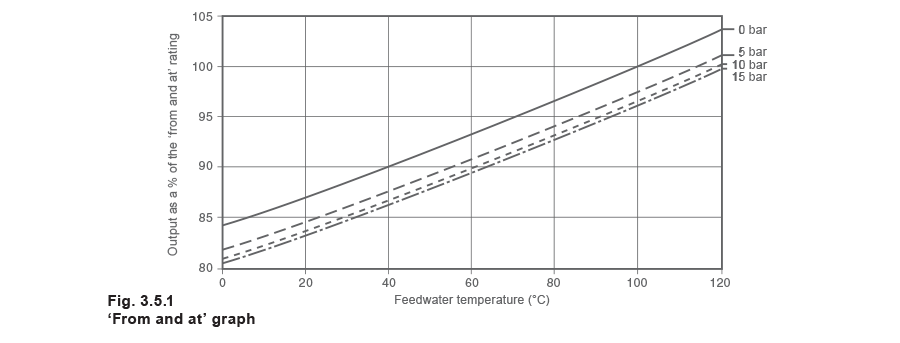The Boiler House

Contents
Boiler Ratings
This tutorial explains the three most commonly used boiler ratings: The 'From and at' rating for evaporation, the kW rating for heat output, and boiler horsepower.
'From and at' rating
The ‘from and at’ rating is widely used as a datum by shell boiler manufacturers to give a boiler a rating which shows the amount of steam in kg/h which the boiler can create ‘from and at 100°C’,at atmospheric pressure. Each kilogram of steam would then have received 2 257 kJ of heat from the boiler.
Shell boilers are often operated with feedwater temperatures lower than 100°C. Consequently the boiler is required to supply enthalpy to bring the water up to boiling point.
Most boilers operate at pressures higher than atmospheric, because steam at an elevated pressure carries more heat energy than does steam at 100°C. This calls for additional enthalpy of saturation of water. As the boiler pressure rises, the saturation temperature is increased, needing even more enthalpy before the feedwater is brought up to boiling temperature.
Both these effects reduce the actual steam output of the boiler, for the same consumption of fuel.
The graph in Figure 3.5.1 shows feedwater temperatures plotted against the percentage of the ‘from and at’ figure for operation at pressures of 0, 5, 10 and 15 bar g.
The application of the ‘from and at’ rating graph (Figure 3.5.1) is shown in Example 3.5.1, as well as a demonstration of how the values are determined.
Example 3.5.1
A boiler has a ‘from and at’ rating of 2 000 kg/h and operates at 15 bar g. The feedwater temperature is 68°C.
The use of Equation 3.5.1 will determine a factor to produce the same result:
Note: These values are all from steam tables.
Using the information from Example 3.5.1 and the Equation 3.5.1 the evaporation factor can be calculated:
kW rating
Some manufacturers will give a boiler rating in kW. This is not an evaporation rate, and is subject to the same ‘from and at’ factor.
To establish the actual evaporation by mass, it is first necessary to know the temperature of the feedwater and the pressure of the steam produced, in order to establish how much energy is added to each kg of water. Equation 3.5.2 can then be used to calculate the steam output:
Example 3.5.2
A boiler is rated at 3 000 kW (kJ/s) and operates at 10 bar g with a feedwater temperature of 50°C. How much steam can be generated?
Where, from using the tables on the Spirax Sarco website:
Kesselpferdestärken (BoHP)
Diese Einheit wird eigentlich nur in den USA und Australien verwendet. Die Kesselpferdestärke entspricht nicht den allgemein bekannten 550 ft lbf/s und der normalerweise verwendete Umrechnungsfaktor von 749 Watt = 1 Pferdestärke kann nicht angesetzt werden.
USA und Australien
Die in den USA und Australien weit verbreitete Definition einer Kesselpferdestärke ist die erforderliche Energiemenge, um 34,5 lb Wasser bei 212 °F unter atmosphärischen Bedingungen zu verdampfen.
Beispiel 3.5.4
Ein Kessel hat eine Leistung von 500 BoHP. Wie hoch ist die Dampfleistung?
Wichtig: Im Wesentlichen ist das ähnlich wie bei der „von und bei“- Leistung; der Einsatz von Speisewasser mit niedrigeren Temperaturen und Dampf bei höheren Drücken reduziert die erzeugte Dampfmenge.
In der Praxis heißt das: Eine BoHP-Kennzahl von 28 bis 30 lb/h wäre unter Berücksichtigung des Dampfdrucks und durchschnittlicher Speisewassertemperaturen eine realistischere, maximale Dauerleistung.
Daher wäre praxisgerechtes Ergebnis:
Daraus folgt: Wenn 17 250 lb/h Dampf erforderlich sind, wäre ein 500 BoHP Kessel zu klein und der Anwender müsste einen Kessel mit folgender Leistung spezifizieren:







